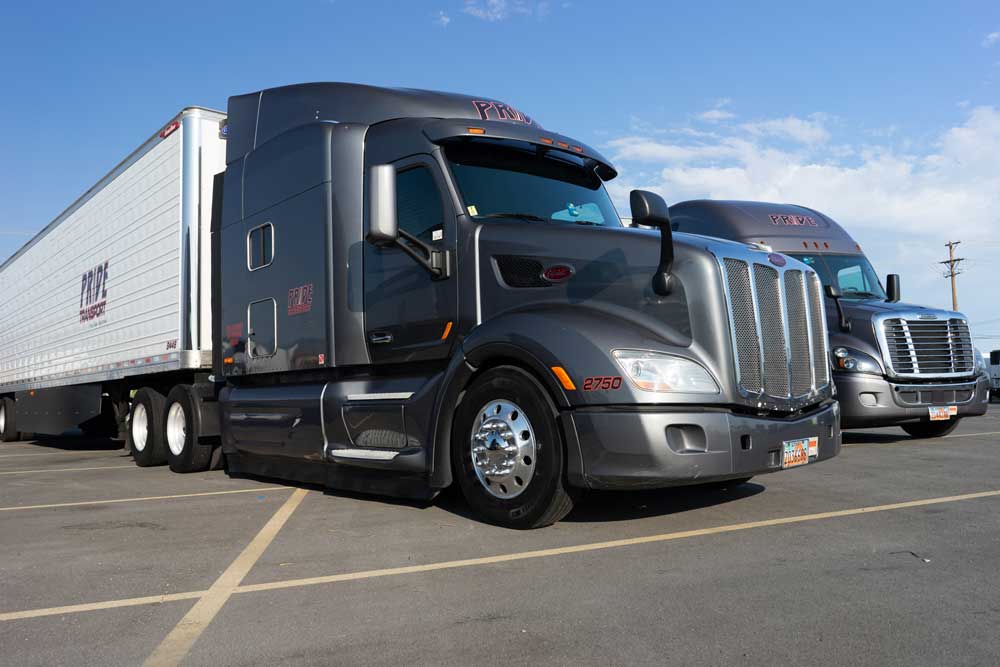by Pride Transport | Jan 13, 2022
Most drivers understand the fact that a semi-truck’s size and weight affect its ability to stop. But how long does it take for a semi-truck to stop? What factors affect the stopping distance? Are there certain stopping requirements for semi-trucks? In this blog, learn about the differences between how passenger cars and trucks come to a stop, and how a driver can learn to safely operate a semi in traffic.
NHTSA Stopping Requirements for Trucks
The National Highway Traffic Safety Administration (NHTSA) is the agency that regulates interstate trucking and is responsible for keeping people safe on the roadways. When it comes to driving semi-trucks, it’s important for drivers to understand how and when to stop at a safe distance. While an exact physics equation involving velocity, mass, and kinetic energy is used to determine stopping distance, drivers won’t need to understand physics to understand braking standards.
The NHTSA published a distance chart outlining the amount of space a semi-truck needs in order to stop safely, considering both the speed it is traveling and its braking system.
Currently, according to stopping distance requirements under the Federal Motor Vehicle Safety Standards (FMVSS) No. 121, trucks were under three different test conditions: loaded-to-GVWR, unloaded, and emergency braking conditions. The following outlines the stopping distance for each condition:
- Under the loaded-to-GVWR condition: When stopping from 60 mph, air-braked single unit trucks must stop within 310 feet and air-braked truck tractors must comply within 355 feet.
- Under the unloaded condition: At 60 mph, single unit trucks and truck tractors must stop within 335 feet.
- Under the emergency brake condition: At 60 mph, single-unit trucks must stop within 613 feet and tractors must stop within 720 feet.
In general, large trucks must have more braking distance because stopping a greater mass requires more distance.
Things That Affect Stopping Distance

Driving a semi-truck requires great care and that includes multiple factors. Depending on the situation, various environmental factors can affect the stopping distance. Inclement weather such as rain, snow, or ice can increase stopping distance.
Debris such as leaves and litter on the road, as well as the pavement’s slope and traction of the road will also increase a semi-truck stopping distance, even if the truck has brand new tires.
The load of a truck affects stopping distance. For example, a heavy semi-truck that is fully loaded requires a distance of about two football fields (about 200 yards) to stop, even traveling in good road conditions at highway speeds. Also, keep in mind that while trucks accelerate more slowly uphill and they may gain speed quickly traveling downhill.
Another important factor that affects a truck’s stopping distance is the driver’s reaction time, which includes their level of alertness and soberness. Sometimes vehicles suddenly cut in front of a semi-truck and reduce a truck's allowable safe stopping distance.
A semi-truck’s large size and weight increases driving challenges, which includes the ability to accelerate, brake, and maneuver. It’s important to give semi-trucks the appropriate amount of space necessary to come to a full stop. Any accidents involving trucks may cause very serious injuries, since trucks are often 20 to 30 times heavier than passenger vehicles.
Semi-truck Stopping Distance Compared to Average Passenger Vehicle
To put it simply, the time it takes for a semi-truck to stop is different compared to a car. At bare minimum, it takes a semi-truck 40% percent longer to come to a complete stop compared to the average passenger vehicle. This time can be greatly increased depending on other factors such as the braking system used by the specific semi-truck, the road conditions, and driver reaction time.
Under ideal conditions, the stopping distance of semi-trucks and cars should be:
- A normal passenger car traveling at a speed of 65 miles per hour would require about 300 feet to stop.
- A fully-loaded semi-truck traveling at 65 miles per hour would need the stopping distance of about 525 feet.
Additionally, the braking distance of a fully-loaded semi-truck increases at the rate of four times as it picks up speed. So, if a truck doubles its speed, it will require four times the braking distance. This does not account for driver reaction time or for trucks equipped with air brakes, which can increase the stopping distance.
The general rule of thumb here? The heavier the truck and the faster the truck is going, the longer it will take for it to come to a complete stop.
Do Semi Trucks Stop Faster or Slower with a Full Load?
The effect of a truck’s weight and the stopping distance is not as straight-forward as you’d think. When you first think about it, the more weight on a truck, the more work the breaks have to do to stop it, which means more heat that the brakes absorb. Because of this, you’d probably think that fully loaded trucks take longer to stop than empty ones. But that’s not necessarily true.

Truck Driving Jobs at Pride Transport
Truck driving is a big responsibility. Driving long distances and delivering goods is essential but can be an intimidating responsibility. Understanding the safety of truck driving keeps both truck drivers and others on the road safe--especially in traffic when braking might be difficult. Following safety traffic laws protects everyone on the road and keeps the country moving. If you think truck driving might be the right lifestyle for you, learn more about truck driving jobs available at Pride today.